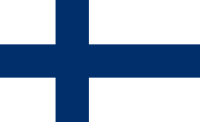 Finland (pronounced /ˈfɪnlənd/), officially the Republic of Finland Finnish: Suomi; Swedish: Finland, is a Nordic country situated in the Fennoscandian region of Northern Europe. It is bordered by Sweden on the west, Norway on the north and Russia on the east, while Estonia lies to its south across the Gulf of Finland.
Finland (pronounced /ˈfɪnlənd/), officially the Republic of Finland Finnish: Suomi; Swedish: Finland, is a Nordic country situated in the Fennoscandian region of Northern Europe. It is bordered by Sweden on the west, Norway on the north and Russia on the east, while Estonia lies to its south across the Gulf of Finland.
Around 5.4 million people reside in Finland, with the majority concentrated in the southern region. It is the eighth largest country in Europe in terms of area and the most sparsely populated country in the European Union. Finland is a parliamentary republic with a central government based in Helsinki and local governments in 342 municipalities. A total of about one million residents live in the Greater Helsinki area (which includes Helsinki, Espoo, Kauniainen and Vantaa), and a third of the country’s GDP is produced there. Other larger cities include Tampere, Turku, Oulu, Jyväskylä, Lahti, Kuopio and Kouvola.
Finland was historically a part of Sweden and from 1809 on, an autonomous Grand Duchy within the Russian Empire. Finnish Declaration of Independence from Russia in 1917 was followed by a civil war, wars against the Soviet Union and Nazi Germany, and a period of official neutrality during the Cold War. Finland joined the United Nations in 1955, the OECD in 1969, the European Union in 1995, and the eurozone since its inception.
Finland was a relative latecomer to industrialization, remaining a largely agrarian country until the 1950s. Thereafter, economic development was rapid, Finland built an extensive welfare state and balanced between the East and the West in global economics and politics. The country tops continuously the international comparisons of national performance. Finland ranks the best country in the world in the 2010 Newsweek survey based on health, economic dynamism, education, political environment and quality of life. Finland has also been ranked the second most stable country in the world and the first in the 2009 Legatum Prosperity rating.
Though Finnish written language could be said to exist since Mikael Agricola translated the New Testament into Finnish in the sixteenth century as a result of the Protestant Reformation, few notable works of literature were written until the nineteenth century, which saw the beginning of a Finnish national Romantic Movement. This prompted Elias Lönnrot to collect Finnish and Karelian folk poetry and arrange and publish them as Kalevala, the Finnish national epic. The era saw a rise of poets and novelists who wrote in Finnish, notably Aleksis Kivi and Eino Leino.
After Finland became independent there was a rise of modernist writers, most famously Mika Waltari. Frans Eemil Sillanpää was awarded the Nobel Prize in Literature in 1939. The second World War prompted a return to more national interests in comparison to a more international line of thought, characterized by Väinö Linna. Literature in modern Finland is in a healthy state. Popular modern writers include Arto Paasilinna, Ilkka Remes, Kari Hotakainenand Jari Tervo, while the best novel is annually awarded the prestigious Finlandia Prize.
Long an agricultural country, Finland accelerated the pace of its industrialization after World War II. By the end of the 20th cent., manufacturing, services, and trade and transportation were the largest segments of the economy, while agriculture (plus forestry and fishing) accounted for less than 5% of employment and GDP.
In agriculture, livestock production is predominant, and dairy products are important. Large numbers of poultry, cattle, hogs, reindeer, and sheep are raised. Leading agricultural commodities include barley, wheat, hay, oats, rye, sugar beets, and potatoes. Though Finland’s mining output is small, it includes a number of important minerals such as iron ore, copper, lead, zinc, chromite, nickel, gold, and silver. The Finnish lumbering industry is one of the largest in Europe, producing a variety of wood and paper products.
Notes from Wikipedia and Answers.com









